|
| |
Archives
iran
THE COMING WARS
What the Pentagon can now do in secret.
by SEYMOUR M. HERSH
|
“This is a war against terrorism, and Iraq is just one campaign. The Bush Administration is looking at this as a huge war zone,” the former high-level intelligence official told me. “Next, we’re going to have the Iranian campaign. We’ve declared war and the bad guys, wherever they are, are the enemy. This is the last hurrah—we’ve got four years, and want to come out of this saying we won the war on terrorism.”
| |
[more]
Next stop, Iran
|
If I was a solider in Iraq, I would shit my pants when I read this. Because the Iranians can only turn the screws a little to make my life hell.
What happens if 100,000 Iranians cross during bad weather, bearing straight for Baghdad? You know, battlefield nukes, or more likely Fuel Air munitions won't stop them. They'll come with armor and artillery and we're spread out across the country. And all our allies, they'll be home on the next boat.
| |
[more]
photography
Misty Keasler

[more]
thanks to Conscientious
iran
The Phantom Weapons...
by Riverbend
|
The phone hasn't been working for almost a week now. We just got the line back today. For the last six days, I'd pick up the phone and hear... silence. Nothing. This vast nothingness would be followed by a few futile 'hellos' and a forceful punching of some random numbers with my index finger. It isn't always like this, of course. On some days, you can pick up the telephone and hear a bunch of other people screaming "allooo? Allooo?" E. once struck up a conversation with a complete stranger over the phone because they were both waiting for a line. E. wanted to call our uncle and the woman was trying to call her grandson.
The dial-tone came about an hour ago (I've been checking since morning) and I'm taking advantage of it.
The electricity situation isn't very much better. We're getting two hours of electricity (almost continuous) and then eight hours of no electricity (continuous). We still can't get the generators going for very long because of the fuel shortage. Kerosene is really becoming a problem now. I guess we weren't taking it very seriously at first because, it really is probably the first time Iraq has seen a kerosene shortage and it is still difficult to believe. They say in 1991 when there was a gasoline shortage which lasted for the duration of the war and some time after, kerosene was always plentiful. This isn't the situation now. We're buying it for obscene prices and it's really only useful for the lamps and the heaters.
It feels like just about everyone who can is going to leave the country before the elections. They say the borders between Syria and Jordan might be closed a week before elections so people are rushing to get packed and get out. Many families are simply waiting for their school-age children to finish mid-year finals or college exams so they can leave.
| |
[more]
Riverbend, a young woman in Baghdad, has had the best writing on living in under the occupation. Her blog is going to be a book...
Baghdad Burning
Girl Blog from Iraq

[more]
Buy the book or just go back and read her archives.
thanks to Body and Soul
"The Tent of Occupation"
Fallujah's Refugees Won't Return Home, Won't Vote
By ROBERT FISK
|
They live beneath old fly-blown tents in the car-park of the Mustafa mosque and their canvas-roofed kitchen stands next to a pool of raw sewage, but the refugees from Fallujah will not return home.
| |
[more]
Bush Says Election Ratified Iraq Policy
|
President Bush said the public's decision to reelect him was a ratification of his approach toward Iraq and that there was no reason to hold any administration officials accountable for mistakes or misjudgments in prewar planning or managing the violent aftermath.
| |
[more]
thanks to Antiwar.com
Tomgram: Michael Schwartz, Desolate Falluja
|
Unfortunately, the only success in the Fallujan campaign so far has been in demonstrating "the consequences" that would accrue to cities that harbored guerrillas. Falluja was gutted. Two months after the invasion, Erik Eckholm of the New York Times described the city as "a desolate world of skeletal buildings, tank-blasted homes, weeping power lines and severed palm trees." At least a quarter of its homes were fully destroyed, and virtually all the others were severely damaged. Blown out windows, wrecked furniture, three-foot blast holes in walls, and disintegrated doors demonstrated that American troops had relentlessly applied what they jokingly called the "FISH" strategy (Fighting in Someone's House), which involved "throwing a hand grenade into each room before checking it for unfriendlies." Since (in the words of Lt. Gen. Sattler) "each and every house" was searched, very few remained livable.
| |
[more]
New intelligence reports raise questions about U.S. mission in Iraq
|
A series of new U.S. intelligence assessments on Iraq paints a grim picture of the road ahead and concludes that there's little likelihood that President Bush's goals can be attained in the near future.
Instead of stabilizing the country, national elections Jan. 30 are likely to be followed by more violence and could provoke a civil war between majority Shiite Muslims and minority Sunni Muslims, the CIA and other intelligence agencies predict, according to senior officials who've seen the classified reports.
| |
[more]
How Americans Were Seduced by War
|
Americans have been betrayed. Sooner or later Americans will realize that they have been led to defeat in a pointless war by political leaders who they inattentively trusted. They have been misinformed by a sycophantic corporate media too mindful of advertising revenues to risk reporting truths branded unpatriotic by the propagandistic slogan, "you are with us or against us."
| |
[more]
U.S. Military Resorting to Collective Punishment
|
The U.S. military is resorting to collective punishment tactics in Iraq similar to those used by Israeli troops in the occupied territories of Palestine, residents say.
| |
[more]
Hotel Room Journalism
The US Press in Iraq
|
"Hotel journalism" is the only phrase for it. More and more Western reporters in Baghdad are reporting from their hotels rather than the streets of Iraq's towns and cities. Some are accompanied everywhere by hired, heavily armed Western mercenaries. A few live in local offices from which their editors refuse them permission to leave. Most use Iraqi stringers, part-time correspondents who risk their lives to conduct interviews for American or British journalists, and none can contemplate a journey outside the capital without days of preparation unless they "embed" themselves with American or British forces.
| |
[more]
thanks to Steve Gilliard's News Blog
The US Army is cracking, bit by bit
|
People still worry about the draft, but this sounds like a story from 1970, which means a draft would only add logs on a fire. When soldiers are deserting from combat units, that's a bad thing. The indiscipline will only spread to units in Iraq. The Army is falling apart, quietly, but certainly.
| |
[more]
RAND to seek ways to avoid draft
|
A reliable source tells me that RAND has been contracted by the government to come up with a way to avoid instituting a draft, despite the desperate needs for more combat forces.
The solution? Outsource desk and logistics jobs to private companies while pushing those "chairborne" warriors out of their offices into fighting units.
| |
[more]
|
Wednesday January 19 2005
|
astronomy
Cassini-Huygens

[more]
thanks to coincidences
media
A televisual fairyland
The US media is disciplined by corporate America into promoting the Republican cause
|
On Thursday, the fairy king of fairyland will be recrowned. He was elected on a platform suspended in midair by the power of imagination. He is the leader of a band of men who walk through ghostly realms unvisited by reality. And he remains the most powerful person on earth.
How did this happen? How did a fantasy president from a world of make believe come to govern a country whose power was built on hard-headed materialism? To find out, take a look at two squalid little stories which have been concluded over the past 10 days.
The first involves the broadcaster CBS. In September, its 60 Minutes programme ran an investigation into how George Bush avoided the Vietnam draft. It produced memos which appeared to show that his squadron commander in the Texas National Guard had been persuaded to "sugarcoat" his service record. The programme's allegations were immediately and convincingly refuted: Republicans were able to point to evidence suggesting the memos had been faked. Last week, following an inquiry into the programme, the producer was sacked, and three CBS executives were forced to resign.
The incident couldn't have been more helpful to Bush. Though there is no question that he managed to avoid serving in Vietnam, the collapse of CBS's story suggested that all the allegations made about his war record were false, and the issue dropped out of the news. CBS was furiously denounced by the rightwing pundits, with the result that between then and the election, hardly any broadcaster dared to criticise George Bush. Mary Mapes, the producer whom CBS fired, was the network's most effective investigative journalist: she was the person who helped bring the Abu Ghraib photos to public attention. If the memos were faked, the forger was either a moron or a very smart operator.
| |
[more]
thanks to Yolanda Flanagan
photography
Michael Wolf
Architecture of Density

[more]
thanks to Conscientious
fascism
The Fritz Stern Speech
|
Allow me a few remarks not about the banality of evil but about its triumph in a deeply civilized country. After the Great War and Germany’s defeat, conditions were harsh and Germans were deeply divided between moderates and democrats on the one hand and fanatic extremists of the right and the left on the other. National Socialists portrayed Germany as a nation that had been betrayed or stabbed in the back by socialists and Jews; they portrayed Weimar Germany as a moral-political swamp; they seized on the Bolshevik-Marxist danger, painted it in lurid colors, and stoked people’s fear in order to pose as saviors of the nation. In the late 1920s a group of intellectuals known as conservative revolutionaries demanded a new volkish authoritarianism, a Third Reich. Richly financed by corporate interests, they denounced liberalism as the greatest, most invidious threat, and attacked it for its tolerance, rationality and cosmopolitan culture. These conservative revolutionaries were proud of being prophets of the Third Reich—at least until some of them were exiled or murdered by the Nazis when the latter came to power. Throughout, the Nazis vilified liberalism as a semi-Marxist-Jewish conspiracy and, with Germany in the midst of unprecedented depression and immiseration, they promised a national rebirth.
Twenty years ago, I wrote about “National Socialism as Temptation,” about what it was that induced so many Germans to embrace the terrifying specter. There were many reasons, but at the top ranks Hitler himself, a brilliant populist manipulator who insisted and probably believed that Providence had chosen him as Germany’s savior, that he was the instrument of Providence, a leader who was charged with executing a divine mission. God had been drafted into national politics before, but Hitler’s success in fusing racial dogma with a Germanic Christianity was an immensely powerful element in his electoral campaigns. Some people recognized the moral perils of mixing religion and politics, but many more were seduced by it. It was the pseudo-religious transfiguration of politics that largely ensured his success, notably in Protestant areas.
German moderates and German elites underestimated Hitler, assuming that most people would not succumb to his Manichean unreason; they didn’t think that his hatred and mendacity could be taken seriously. They were proven wrong. People were enthralled by the Nazis’ cunning transposition of politics into carefully staged pageantry, into flag-waving martial mass. At solemn moments, the National Socialists would shift from the pseudo-religious invocation of Providence to traditional Christian forms: In his first radio address to the German people, twenty-four hours after coming to power, Hitler declared, “The National Government will preserve and defend those basic principles on which our nation has been built up. They regard Christianity as the foundation of our national morality and the family as the basis of national life.”
| |
[more]
thanks to Bad Attitudes
ulf photography
In the early 1970s I belonged to a group of fine art photographers in Seattle. The realy gonzo ones used 4x5 and there was one guy that used an 8x10. We thought he was crazy becaused instead of just contact printing he enlarged them. His name was Ray Meuse. I think it was around 1988 that I went to a show of Ray's new work. The 8x10 wasn't big enough for him. He had built himself a 16x20 camera. That's the size of the negative in inches. Not only did he do 16x20 contact prints but he enlarged them to something like 5x6 feet. He had to special order the film from Kodak to the tune of about $3,000. Times have changed. He is not alone.
Mamut Photo
|
First, lest start with the obvious question : What is ULF ?
Ultra-Large format photography, at least by my definition, is photography using any camera producing a negative larger than 8 x 10 inches. This includes both classic and modern cameras, and various formats, from the almost small 7x17 panoramic and the 11x14 portrait cameras to the huge 20x24 polaroid cameras. It is the world of extremes, extreme negative size and image quality, but also extreme camera weight, extreme variability and extreme costs.
You are stepping in a world where the standards of smaller sizes that we take for granted, like film holder compatibilities, are thrown out of the window. Here everything is hand-made, everything is special order, six months waiting period, here, we're madmen and women playing with very big cameras...
Second, and most important question... : Why ?
Or as i like to put it : "What in god's name possessed me to get a 35 pounds camera on a 15 pounds tripod out in the woods when i could have brought a nice little techno-digital-thingy that weighs 398 grams ?"
And the answer, the only answer i can come up with that's not technical, that doesn't talk about resolution, platinum prints, tonal rendition or scheipflung depth of field control, well that answer is quite simply, because I like it and because I can...
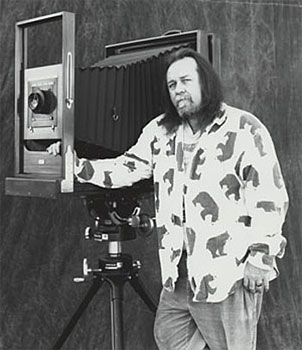
| |
[more]
J&C Photo carries sheet film in sizes up to 20x24. I'm having really bad thoughts. Someone please save me!
social security
we didn't have a nickel: social security
|
Imagine a scenario where a retiree hits age 65 and the market tanks....for nine years. Further, imagine that the market tanking coincides with rapid inflation at some point during those nine years. At the same time, keep in mind that millions of Americans have rolled their credit card debt into their largest investment...their home mortgage...and that many of these Americans are committed to paying off that mortgage well into their retirement years.
The Republicans want us to gamble with our retirement. The GOP wants to take a "house built on rock" and move that house onto the sand. The President is so committed to his vision of a "program in crisis" that he cannot see that Social Security, as it stands, is the healthiest part of a majority of American's retirement plans. It is a system that works, has worked and will work if we run it properly. But to do so requires a committment to good stewardship of our government. That is something, friends, that the GOP is incapable of.
The GOP, quite simply, does not believe in good government because they don't believe in government at all. That is not simply a disaster in the making. It is, after the lessons learned by my Grandmother's generation...and the hard work they put into building the policies and government programs that flowed from those lessons...an abject crime.
| |
[more]
There is no Crisis
Protecting the Integrity of Social Security
|
Social Security is America's promise that those who work hard and play by the rules will retire with dignity. Even the most pessimistic of economists agree it will remain solvent for decades. There is no crisis.
| |
[more]
thanks to daily KOS
new photography tools
Two packages arrived on my doorstep. The first one was the Burke & James 5x7. A view camera has been on my photographic wish list for some time. I bought this one because the price was just 5 rolls of film. Now that I've looked at it and played with it, those lines from a Rolling Stones song fit quite well:
You can't always get what you want
But if you try sometimes, well you might find
You get what you need
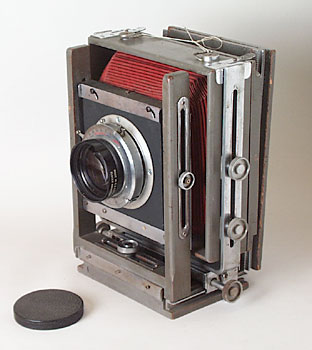
No shit!
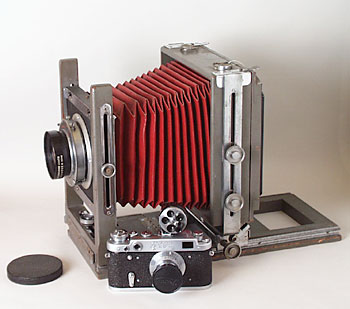
This doesn't have the rigidity of the modern monorail view cameras but, when you look at it closely, it does everthing you need a view camera to do but just not with the finesse of the expensive ones. It also only weighs around 7 or 8 pounds. The Burke and James were always sort of a blue collar view camera.
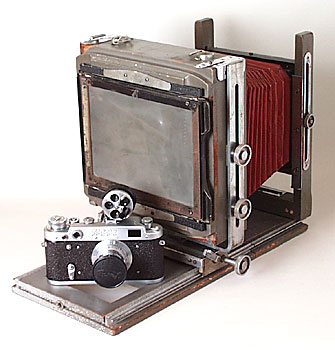
This is a tailboard model. The focusing is done only with the rear standard. A simpler design that's cheaper to make and works just fine. See the big piece of glass? That's the negative size. Now, I had been looking for a 4x5 but, as I mentioned before, I used to have a 5x7 that Blaine has now. I've kind of wanted one for contact printing but I still need to be able to shoot 4x5.
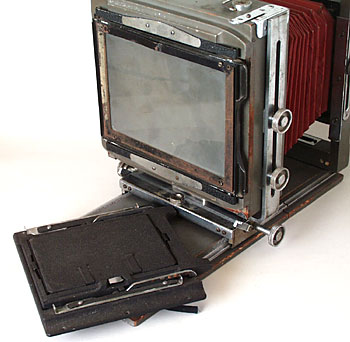
The black thing is the 4x5 Graflok back that came with the camera. The back of the camera comes off and can be rotated for vertical shots. It can also be replaced with another back with the Graflok back mounted on it. The 4x5 lets me use more types of film as well as a Polaroid back that I have as well as roll film backs that I don't have, yet. Lots of them on eBay. And then opportunity banged on my door, again, and there was a Burke and James 5x7 back on eBay this afternoon.
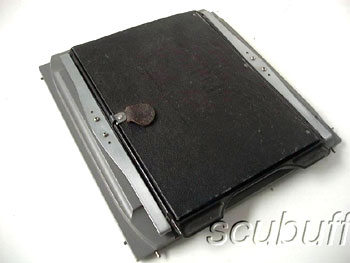
It's now mine. Another package to wait for. It has a hood and all I need to do is take the glass out of the one on the camera and put in a wood insert to mount the Graflok back on.
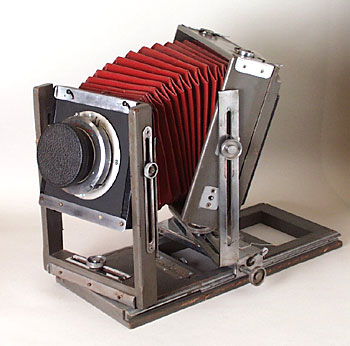
This is another big reason for a view camera. It has the ability to do perspective control. It has all the rises, slides, swings and tilts on both front and rear standards that a person could want. I've been wrestling with refinishing it. Some like to remove the gray paint and expose the nice wood underneath but the gray paint and the red bellows is what a Burke and James is supposed to be. I've thought about putting on a new coat of gray but right now I'm leaning to just cleaning it up and polishing the chrome. Then I won't have to worry about scratching a new paint job. The bellows is light tight although a little frayed in spots. I think I will keep it as it is. It's kind of like the old pickups you see here on Whidbey Island. The paint is oxidized and there may be a dent here and there but they are working trucks. They actually haul things.

The other package that arrive was the lenses from Marja-Leena. The one right is the Schneider 5.6/150. It turns out to be a Comparon enlarging lens and not a real good one at that. One of the forums suggested making it into a loupe. I do need a good loop. The other lens is a G-Claron 9/210. All the entries in forums, about this lens, rave about it. Very, very, very sharp. It's a copy lens but it works very well for general photography when stopped down to f22. It stops all the way down to f90. It's also small and light. S.K. Grimes can mount it in a shiny new Copal #1 shutter, with f stop markings, for $300. One of these lense, in a Copal #1, went for $435 today on eBay. It will cover 8x10. It's going to be sweet. Marja-Leena was kind enough to only charge me postage which was US$10.50. I think, in keeping with the simplicity and low cost of the camera, I'm going to use a Packard shutter with this lens. I have one. Somewhere.
The camera came with a 254mm lens which covers 5x7. A 254 and a 210, for a 5x7, is equivalent to a 52mm and a 44mm lens in 35mm. In 4x5 it would be the equivalent of a 63mm and 53mm. I'm looking for the smallest G-claron, the 9/150. That covers 5x7 with an equivalency of 31mm and would be equivalent to 38mm on the 4x5. That should do for starters. The 210 would be equivalent to a 29mm lens on an 8x10. Hmmmm.
mlk
The Martin Luther King, Jr. Papers Project
|
"For nonviolence not only calls upon its adherents to avoid external physical violence, but it calls upon them to avoid internal violence of spirit. It calls on them to engage in that something called love. And I know it is difficult sometimes. When I say love at this point, I'm not talking about an affectionate emotion. It's nonsense to urge people, oppressed people, to love their oppressors in an affectionate sense. I'm talking about something much deeper. I'm talking about a sort of understanding, creative, redemptive goodwill for all men."
Martin Luther King, Jr., Address at the Freedom Rally in Cobo Hall, 23 June 1963
| |
[more]
A Tribute to Dr. Martin Luther King, Jr.
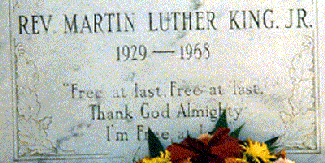
[more]
Out of the Darkness
by Bob Herbert
|
Never since his assassination in 1968 have I felt the absence of Martin Luther King more acutely. Where are today's voices of moral outrage? Where is the leadership willing to stand up and say: Enough! We've sullied ourselves enough.
I'm convinced, without being able to prove it, that those voices will emerge. There was a time when no one had heard of Dr. King. Or Oscar Arias Sanchez. Or Martin O'Brien, who founded the foremost human rights organization in Northern Ireland, and who tells us: "The worst thing is apathy - to sit idly by in the face of injustice and to do nothing about it."
| |
[more]
thanks to daily KOS
william is gone
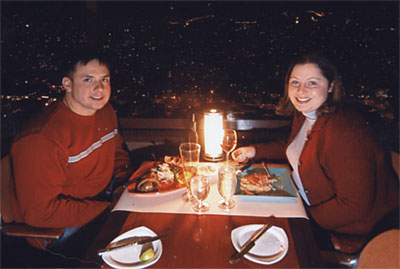
That is a picture of William and my daughter Jenny. That was taken Monday or Tuesday night. They were having dinner at the top of the Space Needle. Katie, Robby, and I watched their kids, Robyn and Evan, for two days so they could have some alone time in Seattle before he had to return to Iraq. They had a really good time.
It was a treat spending time with William. He took off this morning at 6am — destination Ramadi. He won't be back until August. We will greatly miss him.
|
|
|
|














